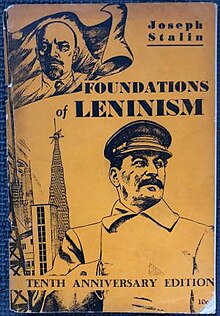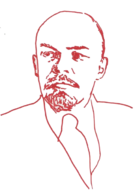Foundations of Leninism
Foundations of Leninism is a book (originally a series of lectures) by Iosif Stalin, which describes the theory and tactics of Marxism–Leninism. It does not explain the underlying Marxist principles, but specifically the new developments of Marxism–Leninism. Stalin denies that Marxism–Leninism is a purely Russian phenomenon or just the application of Marxism to Russian conditions, instead explains how Leninism is the response of the proletarian movement to imperialism, which hadn't yet developed in Marx's and Engels' time. While he notes Lenin's fight against the revisionists of the II. International, he also denies that Lenin only revived revolutionary Marxism. He emphasizes Leninism as a step forward, an advancement of Marxism.
Content
Chapter 1: Historical Roots of Leninism
In this chapter, Stalin summarizes the contradictions of imperialism and explains how the Leninist movement could form in Russia despite it not being a classical imperialist country. This is because Russia was the centre of all kinds of oppression: the Russian people were exploited both by capitalism and by their tsar, while Russia itself, allied with the western imperialists, conquered and oppressed other regions. The western imperialists also had a great interest in Russian resources, so they would intervene in any fight against these conditions. This is why the October Revolution could only be an anti-imperialist revolution.
Chapter 2: Method
In the second chapter, he explains the methods of Leninism and how they are different from those of the II. International. These methods are: unity of theory and practice, as opposed to only theoretical dogmas of the II. International; winning the trust of the proletariat with actions, not with slogans; preparing the masses and the party for a proletarian revolution; self-criticism inside the party. He continues with Marx's and Lenin's refutal of some dogmas of the II. International, adding some practical examples from the experience of the October Revolution. Also, he provides some examples to the statement that the II. International and Kautsky were treacherous and opportunist.
Chapter 3: Theory
The author proceeds to explain the Leninist theory. First, he denies that Leninists do not care about theory, only about practice. While he agrees that theory is worthless without practice, he states that practice is also blind without theory. He quotes Lenin on the statement that a revolutionary movement cannot exist without revolutionary theory and that only a party led by the most advanced theory can have the role of a vanguard fighter. The second sector of the chapter on theory criticizes the theory of spontaneity, which is against an organized party leading the working class. The third chapter then explains the opposite, Lenin's theory of proletarian revolution. Stalin analyses the question of where the revolution can start: not in the countries with most developed industry, not where there are the most proletarians, not where there is more democracy, but where imperialism is the weakest. So it is also possible for the revolution to happen in countries which do not have a very developed industry. He denies that the communist revolution has to happen some time after the bourgeois revolution, instead explaining that the bourgeois revolution can transform into a proletarian one. He explains that Lenin was not opposed to a "permanent revolution" because of its continuity, but because its supporters underestimated the role of the peasantry, a significant force for completely liquidating the remains of feudalism. Also, the "permanentists" distorted Marx's theory of permanent revolution, making it practically useless. Then, he explains why it is possible for the revolution to be victorious in one country and what conditions are necessary for that.
Chapter 4: The Dictatorship of the Proletariat
Stalin emphasizes that it is not enough to just seize the power, that it is also necessary to solidify it afterwards. Because the bourgeoisie, even if it was overthrown, still has great advantages over the proletariat, which it will use against the new system, like money, better education and good relations to the neighbouring capitalist countries. Also, while small production also has to be abolished, it is impossible to immediately chase them away or oppress them, a slow process is necessary to get the small producents into the socialist mode of production. He notes that that will not be a short period, but a long and tough fight. Then, he details how exactly a dictatorship of the proletariat is organized: First, it is not a democracy for everyone. It is democratic to the proletariat and the propertyless, while being a dictatorship towards the bourgeoisie. Second, it cannot be the result of a peaceful transformation. In the last section, it is explained how the Soviet power is a dictatorship of the proletariat.
Chapter 5: The Peasant Question
The author specifies the Leninist position on the peasant question: Leninists think that most of the peasantry has revolutionary potential and must be supported in their fight for liberation. He illustrates this with the example of Russia, where the peasantry allied with the proletariat because there was no other force that was really on their side. He states that after the solidification of Soviet power, the small peasants must get into cooperatives, the agriculture must be collectivized, because this is necessary for economic construction, the next very important task.
Chapter 6: The National Question
The sixth chapter answers the national question from a Leninist perspective. First, Stalin criticizes the II. International because it only cared about some European peoples, not those of Asia and Africa which were most oppressed. The II. International did not put whites and blacks on the same level, but as the "civilized" and the "uncivilized". On the contrary, Leninism wants the liberation of all who are oppressed by imperialism, with no such divisions. Leninists believe that national liberation movements have revolutionary potential against imperialism, so the proletariat of the oppressing countries must support these movements, although not if they are reactionary. Stalin explains that the workers must be educated in the spirit of internationalism and that the communists must resolutely fight against chauvinism among the "socialists" of the dominant countries like England or Japan, which refuse to support the liberation movements in their own country's colonies.
Chapter 7: Strategy and Tactics
Chapter 8: The Party
The author shows the differences between other parties, which can only do something in the parliament, and a Leninist party. A Leninist party is an advanced and organized detachment of the working class, it fights for the working class and is inseparable from the working class. While there are other organizations of the working class, the Leninist party leads these organizations either because they are formally subordinated to the party, or because party members which also belong to these organizations have much influence. The party is a tool for making and securing the dictatorship of the proletariat. It must have a unity of will, which is fundamentally incompatible with factions. So no factions are allowed. It is still possible to have conflicts of opinions. But when a decision is finally made, all party members must follow it. Since the party can also be infiltrated from within, it is also necessary to purge it of the opportunists, reformists, etc.
Chapter 9: Style in Work
The last chapter explains the Leninist method of work. This method consists of both revolutionary sweep and efficiency. The revolutionary sweep is the force that destroys the old and opens new perspectives. Without it, progress is impossible. But without efficiency, it could degenerate into empty decrees and phrase-mongering. But narrow practicalism alone, without any vision or understanding of the connections, causes to go away from the path of revolution. So a Leninist functionary needs both revolutionary sweep and work efficiency.
Criticism
This section is empty. You can help by adding to it. |

